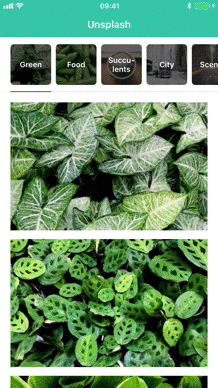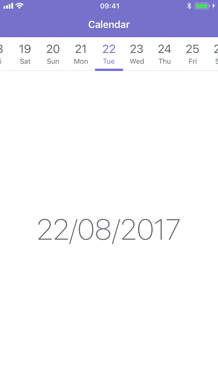Parchment 允许您在视图控制器之间分页,同时显示随内容滚动的任何类型的通用指示器。以下是使用 Parchment 的一些好处
-
高度可定制
菜单项是使用UICollectionView构建的,这意味着您可以显示几乎任何您想要的内容。您甚至可以子类化布局以创建完全自定义的行为。 -
内存高效:
Parchment 仅在需要时分配视图控制器,这意味着如果您有很多视图控制器,则无需预先初始化它们。 -
无限滚动:
由于视图控制器仅在您滚动时分配,因此您可以创建无限大的数据源。这非常适合诸如 日历 之类的东西。
Parchment 是围绕 PagingViewController 类构建的。您可以使用视图控制器数组初始化它,它将使用每个视图控制器的 title 属性为每个视图控制器显示菜单项。
let firstViewController = UIViewController()
let secondViewController = UIViewController()
let pagingViewController = PagingViewController(viewControllers: [
firstViewController,
secondViewController
])
了解更多: 基本用法
在大多数情况下,使用视图控制器数组初始化 PagingViewController 都可以,但是如果您有多个视图控制器,您可能不想预先分配它们。如果您要显示固定数量的视图控制器,您可以通过实现 PagingViewControllerDataSource 来设置您自己的数据源
extension ViewController: PagingViewControllerDataSource {
func numberOfViewControllers(in pagingViewController: PagingViewController) -> Int {
return 10
}
func pagingViewController(_ pagingViewController: PagingViewController, viewControllerAt index: Int) -> UIViewController {
return ChildViewController(index: index)
}
func pagingViewController(_: PagingViewController, pagingItemAt index: Int) -> PagingItem {
return PagingTitleItem(title: "View \(index)", index: index)
}
}
然后您需要设置 dataSource 属性并选择初始项目
let pagingViewController = PagingViewController()
pagingViewController.dataSource = self
pagingViewController.select(index: 0)
使用数据源意味着 Parchment 将仅为当前选定的项目及其任何同级项目分配视图控制器。如果您有很多视图控制器,那么这比使用 PagingViewController(viewControllers:) 更节省内存。
阅读更多: 使用数据源
使用 PagingViewControllerDataSource 意味着您需要知道要显示多少个视图控制器。如果您正在创建类似 日历 的东西,则视图控制器的数量可以是无限大的。在这种情况下,您可以使用 PagingViewControllerInfiniteDataSource 协议
extension ViewController: PagingViewControllerInfiniteDataSource {
func pagingViewController(_: PagingViewController, viewControllerFor pagingItem: PagingItem) -> UIViewController {
return ItemViewController(item: pagingItem)
}
func pagingViewController(_: PagingViewController, itemBefore pagingItem: PagingItem) -> PagingItem? {
guard let item = pagingItem as? Item else { return nil }
return Item(index: item.index - 1)
}
func pagingViewController(_ : PagingViewController, itemAfter pagingItem: PagingItem) -> PagingItem? {
guard let item = pagingItem as? Item else { return nil }
return Item(index: item.index + 1)
}
}
然后设置 infiniteDataSource 属性并选择初始项目
let pagingViewController = PagingViewController()
pagingViewController.infiniteDataSource = self
pagingViewController.select(pagingItem: Item(index: 0))
此模式与 UIPageViewControllerDataSource 协议非常相似。主要区别在于,您不必直接返回视图控制器,而是必须返回一个符合 PagingItem 协议的实例。Parchment 将为选定的 PagingItem 递归调用这些方法,直到可用空间被填满。
阅读更多: 使用无限数据源
您可以使用编程方式选择项目
func select(pagingItem: PagingItem, animated: Bool = false)
假设您要选择第一个项目
override func viewDidLoad() {
super.viewDidLoad()
if let first = pagingViewController.children.first as? PagingItem {
pagingViewController.select(pagingItem: first)
}
}
或者,如果您已设置 dateSource 属性,则可以根据其索引选择项目
func select(index: Int, animated: Bool = false)
您可以使用此方法重新加载数据
func reloadData()
如果先前选择的项目仍然是更新数据的一部分,这将保留先前选择的项目。如果不是,它将选择列表中的第一个项目。它还将重新加载页面视图控制器中显示的视图控制器。如果您只想重新加载菜单项,则可以使用此方法
func reloadMenu()
当使用 PagingViewControllerInfiniteDataSource 时,调用 reloadData() 将不起作用,因为那时我们需要知道初始项目应该是什么。在这种情况下,您应该使用此方法
func reloadData(around: PagingItem)
这将标记给定的分页项目为已选中,并在其周围生成新项目。
Parchment 通过 PagingViewControllerDelegate 协议为过渡过程的每个步骤提供委托方法。
protocol PagingViewControllerDelegate: class {
func pagingViewController(
_: PagingViewController,
isScrollingFromItem currentPagingItem: PagingItem,
toItem upcomingPagingItem: PagingItem?,
startingViewController: UIViewController,
destinationViewController: UIViewController?,
progress: CGFloat)
func pagingViewController(
_: PagingViewController,
willScrollToItem pagingItem: PagingItem,
startingViewController: UIViewController,
destinationViewController: UIViewController)
func pagingViewController(
_ pagingViewController: PagingViewController,
didScrollToItem pagingItem: PagingItem,
startingViewController: UIViewController?,
destinationViewController: UIViewController,
transitionSuccessful: Bool)
func pagingViewController(
_ pagingViewController: PagingViewController,
didSelectItem pagingItem: PagingItem)
}
默认情况下,菜单项的大小由 menuItemSize 属性控制。如果您需要单独控制每个菜单项的宽度,则可以使用 PagingControllerSizeDelegate 协议
protocol PagingViewControllerSizeDelegate: class {
func pagingViewController(
_: PagingViewController,
widthForPagingItem pagingItem: PagingItem,
isSelected: Bool) -> CGFloat
}
然后在 PagingViewController 上设置 sizeDelegate
let pagingViewController = PagingViewController()
pagingViewController.sizeDelegate = self
Parchment 的构建非常灵活。菜单项是使用 UICollectionView 显示的,因此它们几乎可以显示任何您想要的内容。如果您需要任何进一步的自定义,您甚至可以子类化集合视图布局。所有自定义都由下面列出的属性处理。
要使用自定义单元格,您需要子类化 PagingCell 并为给定的 PagingItem 注册单元格类型
let pagingViewController = PagingViewController()
pagingViewController.register(CalendarPagingCell.self, for: CalendarItem.self)
然后,当您在数据源中返回给定的 PagingItem 时,Parchment 将取消排队您的自定义单元格。您可以为不同的 PagingItem 注册多种单元格类型。
所有自定义属性都在 PagingViewController 上设置
let pagingViewController = PagingViewController()
pagingViewController.menuItemSize = .fixed(width: 40, height: 40)
pagingViewController.menuItemSpacing = 10
菜单项的大小。当使用 sizeDelegate 时,宽度将被忽略。
enum PagingMenuItemSize {
case fixed(width: CGFloat, height: CGFloat)
// Automatically calculate the size of the menu items based on the
// cells intrinsic content size. Try to come up with an estimated
// width that's similar to the expected width of the cells.
case selfSizing(estimatedWidth: CGFloat, height: CGFloat)
// Tries to fit all menu items inside the bounds of the screen.
// If the items can't fit, the items will scroll as normal and
// set the menu items width to `minWidth`.
case sizeToFit(minWidth: CGFloat, height: CGFloat)
}
默认值:.sizeToFit(minWidth: 150, height: 40)
菜单项之间的间距。
默认值:0
菜单项标签的水平约束。
默认值:20
菜单项周围的插距。
默认值:UIEdgeInsets()
enum PagingMenuHorizontalAlignment {
case `default`
// Allows all paging items to be centered within the paging menu
// when PagingMenuItemSize is .fixed and the sum of the widths
// of all the paging items are less than the paging menu
case center
}
默认值:.default
确定滚动内容时菜单项的过渡行为。
enum PagingMenuTransition {
// Update scroll offset based on how much the content has
// scrolled. Makes the menu items transition smoothly as you scroll.
case scrollAlongside
// Animate the menu item position after a transition has completed.
case animateAfter
}
默认值:.scrollAlongside
确定用户如何与菜单项交互。
enum PagingMenuInteraction {
case scrolling
case swipe
case none
}
默认值:.scrolling
集合视图布局的类类型。如果您想使用您自己的布局子类,请覆盖此项。设置此属性将初始化新的布局类型并更新集合视图。
默认值:PagingCollectionViewLayout.Type
确定选定的菜单项在被选中时应如何对齐。实际上与 UICollectionViewScrollPosition 相同。
enum PagingSelectedScrollPosition {
case left
case right
// Centers the selected menu item where possible. If the item is
// to the far left or right, it will not update the scroll position.
// Effectivly the same as .centeredHorizontally on UIScrollView.
case preferCentered
}
默认值:.preferCentered
向选定的菜单项添加指示器视图。指示器宽度将等于选定的菜单项宽度。插距仅水平应用。
enum PagingIndicatorOptions {
case hidden
case visible(
height: CGFloat,
zIndex: Int,
spacing: UIEdgeInsets,
insets: UIEdgeInsets)
}
默认
.visible(
height: 4,
zIndex: Int.max,
spacing: UIEdgeInsets.zero,
insets: UIEdgeInsets(top: 0, left: 8, bottom: 0, right: 8))
指示器视图的类类型。如果您想使用您自己的 PagingIndicatorView 子类,请覆盖此项。
默认值:PagingIndicatorView.self
指示器视图的背景颜色。
默认值:UIColor(red: 3/255, green: 125/255, blue: 233/255, alpha: 1)
在菜单项底部添加边框。边框将与所有菜单项一样宽。插距仅水平应用。
enum PagingBorderOptions {
case hidden
case visible(
height: CGFloat,
zIndex: Int,
insets: UIEdgeInsets)
}
默认
.visible(
height: 1,
zIndex: Int.max - 1,
insets: UIEdgeInsets(top: 0, left: 8, bottom: 0, right: 8))
边框视图的类类型。如果您想使用您自己的 PagingBorderView 子类,请覆盖此项。
默认值:PagingBorderView.self
边框视图的背景颜色。
默认值:UIColor(white: 0.9, alpha: 1)
根据 .safeAreaInsets 属性更新菜单项的内容插距。
默认值:true
用于菜单项上标题标签的字体。
默认值:UIFont.systemFont(ofSize: 15, weight: UIFont.Weight.medium)
用于当前选定的菜单项上标题标签的字体。
默认值:UIFont.systemFont(ofSize: 15, weight: UIFont.Weight.medium)
菜单项上标题标签的颜色。
默认值:UIColor.black
当前选定的菜单项的文本颜色。
默认值:UIColor(red: 3/255, green: 125/255, blue: 233/255, alpha: 1)
菜单项的背景颜色。
默认值:UIColor.white
选定的菜单项的背景颜色。
默认值:UIColor.clear
菜单项后面的视图的背景颜色。
默认值:UIColor.white
Parchment 将与 Swift 的最新公共版本兼容。
- iOS 9.0+
- Xcode 8.0+
Parchment 可通过 CocoaPods 获得。要安装它,请将以下内容添加到您的 Podfile
pod 'Parchment', '~> 3.2'
Parchment 可通过 Swift Package Manager 获得。将 Parchment 作为依赖项添加到您的 Package.swift
.package(url: "https://github.com/rechsteiner/Parchment", from: "3.2.0")
Parchment 也支持 Carthage。要安装它,请将以下内容添加到您的 Cartfile
github "rechsteiner/Parchment" ~> 3.2
有关使用 Carthage 的更多详细信息,请参阅本指南。
这可以在 CHANGELOG 文件中找到。
Parchment 在 MIT 许可证下发布。有关详细信息,请参阅 LICENSE。






